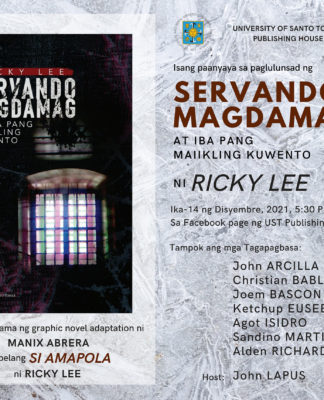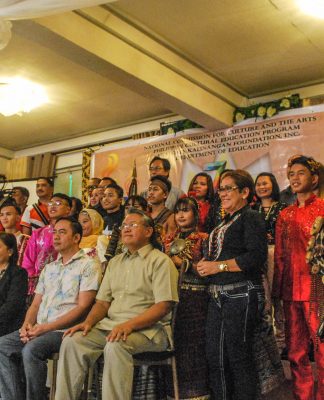THERE are only 15 Thomasian martyrs, no more, no less, the former University archivist has declared.
Contrary to the claim of two other Thomasians that there are 17 Thomasian martyrs, Fr. Fidel Villarroel, O.P., who served as archivist of the University for almost half a century, said that the UST martyrs consist of only 10 saints and five blessed.
Villarroel said there are three groups of UST martyrs: the martyrs of Japan, the martyrs of Vietnam, and the martyrs of Spain.
Among them are St. Antonio Gonzales, O.P., a martyr of Japan who became Rector of UST and Blessed Buenaventura Garcia Paredes, O.P., a martyr of Spain who was a former master of the Order of Preachers. A street in UST is named after Paredes.
According to Villarroel, the other saints of Japan are Domingo De Erquicia, O.P., Lucas Del Espiritu Santo, O.P., Tomas Hioji De Jacinto, O.P., and Guillaume Courtet, O.P. The Thomasian martyr saints in Vietnam are Vicente Liem De la Paz, O.P., Pedro Almato, O.P., and Bishops Domingo Henares, O.P., and Jose Ma. Diaz Sanjurjo, O.P. The four other blessed martyrs in Spain are Jesus Villaverde, O.P., Manuel Moreno, O.P., Pedro Ibañez Alonso, O.P., and Jose Ma. Lopez Carrillo, O.P.
"[The Thomasian martyrs] are the models of Christian fortitude of all times. They gave us the examples of defending the Christian faith by dying for it," said Villarroel.
In the book written by Fr. Noel Abalajon of the Archdiocese of Capiz and that of Central Seminary Spiritual Director Fr. Pedro Tejero, O.P. titled “The UST Martyrs of the Religious Persecution in Spain (1933-1937),” two other names were included: Blessed Maximino Fernandez Marinas and St. Melchor Garcia Sampedro.
Villarroel said in his thesis that Marinas and Sampedro were not Thomasians because they both studied and taught in Spain.
There are no Filipinos on the roster of Thomasian saints and martyrs because priesthood was not open to indios (natives) during the 18th and 19th century. But Lorenzo Ruiz, the first Filipino saint, was a lay companion of Gonzales, et. al., and was martyred with them in Japan.
Celebrating holiness
Meanwhile, the annual week-long celebration dedicated to the Thomasian martyrs was held by the Central Seminary last Sept. 19 to 23 with the theme "Martir na Tomasino: Modelo ng Pagsaksi kay Kristo, Inspirasyon sa Buhay Ko.”
Fr. Nilo Lardizabal, O.P., shared in the symposium titled Psst… Pagtugon sa Tawag: A Call to Holiness how it was like to live by a martyr’s life.
Lardizabal talked about his experiences at the recent World Youth Day in Madrid, Spain, where he and some fellow Filipino Dominicans had to choose whether to sleep in a gymnasium with no ventilation, or on a dirty and damp basketball court.
“In the basketball court, we saw a cross. Maybe it symbolized our petty sacrifices compared to Christ’s. He accepted his cross himself so that others may live,” Lardizabal said.
Lardizabal quoted Blessed John Paul II who said “the path to holiness is to share in the sufferings of God,” adding that people must learn to die a little death in order to live.
“Holiness is more than just suffering. It requires death and understanding,” he said.
Lardizabal said the death of martyrs teaches people great things, but men should be able to relate to the saints by doing good and simple things.
“It is not about doing big things, but doing small things with a big heart,” he said.
Part of the celebration was an exhibit at the Miguel de Benavides Library featuring images of the Thomasian Martyrs as well as articles from magazines, newspapers, and books.
Also featured in the exhibit was Villarroel’s two-volume book Canonization: 16 Martyrs of Nagasaki and former Varsitarian adviser Celso Carunungan’s To Die a Thousand Deaths, which is about the life of St. Lorenzo Ruiz.
In the closing Eucharistic celebration of the week-long event last Sept. 23, Vice Rector for Religious Affairs Fr. Winston Cabading, O.P. said that while most of the Thomasian martyrs were of Spanish descent, students of the University must be proud of them because they were Thomasians.
“The greatness does not come from what we look like or where we’re from, but from who we are. In 400 years, [UST] did not only produce heroes but also saints and martyrs,” Cabading said.















